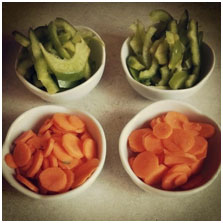How do you remember your mom’s kitchen?
Do you have good or not so good childhood memories related to mealtime and food in general? My most precious memories are in the kitchen where my mommy and nana prepared daily meals. They seemed so joyful and happy, always laughing, singing and joking. Growing up I never had to cook, nevertheless, these sweet memories are responsible for my passion for nutrition and children til’ this day.

When we were little my mom would sit my sister and myself near the kitchen table and gave us the easiest ‘jobs’ to do, picking tiny rocks from the rice, cleaning parsley leaves, cutting the cucumbers with butter knives and even plucking the chickens and collecting their eggs. These jobs never seemed like a chore, rather a fun game.
Being a pediatric nutritionist, one question I get asked a lot is “how to feed picky eaters?”. We’ve all heard about kids who would only eat ‘white’ pasta, or a dry piece of meat without any sauce or flavour enhancer of any kind. And, although we understand they are still little, it does hurt us when they say “yuck” on the food we’ve worked so hard to prepare. What parents are really asking is how to create meals that children will eat on a regular basis? In my opinion, this is an art!
So, how to make meals that children actually enjoy and agree to eat willingly?
Before we get into the ‘how’ let’s talk a little about the ‘why’. Why do kids have a different eating style than adults, why won’t they eat food that is “touching”, that is, mixed up with other ingredients?
There are two main reasons, one is physiological and the other psychological.
Physiologically, children’s taste buds are very concentrated in proximity which makes them extremely sensitive to tastes and flavours. Not all children get upset when their food is “touching” other ingredients, but some do and that is a normal developmental stage. Think about yourself as a child, are there any foods you remember yourself rejecting in childhood but actually liking in adulthood? Taste is an evolving process and we, as parents, should be more mindful and less controlling.
Psychology also plays a huge role in children’s food preferences. Most toddlers and many preschoolers do not like their food to “touch”, some do, but most don’t. This is actually a defence mechanism built into children, and the purpose of it is to avoid poisoning or disease. It works especially when introducing kids to a new food. Think about it from kids’ perspective, all they do is resist change. It has nothing to do with broccoli or kale. They want their morning yogurt or bagel with cream cheese and when you introduce something new to their menu, subconsciously you are encouraging them to change their current reality. Some kids are naturally adventurous and risk takers, so they are more likely to try new foods. Other kids, who are more risk averse by nature, are less likely to try foods for the first time. However, the key with these kids is to keep offering new foods and create positive associations around food and meal time. Many parents get really upset when their kids are not cooperating while introduced to new foods, and later complain that their kids are picky eaters.
There is no such thing as picky eaters ….
I am sorry to shatter a very common myth, but based on my work with families there is really no such thing as picky eaters, only pushy parents who need some parenting tactics and education. Parents hire me as a pediatric nutritionist, yet I spend 80% of my time talking to them about positive psychology and parenting styles instead of nutrition, which only accounts for 20%. So understanding that children have different personalities and temperaments is key to feeding them a balanced and nutritious meal. Your job as a parent is introducing kids to new foods and tastes in the most positive and calm manner possible, the rest is up to them.
Tricks/Hacks for creating meals kids love
I know this is sometimes easier said than done (especially when you have older kids), that’s why I’ve prepared some useful tips to creating meals that kids love
- Use small and cute plates for serving salads, dips and even chopped veggies
- Be creative when offering vegetables. For example, instead of cutting a cucumber into stripes, try to cut it into small circles or diagonally. The pepper can be cut into a flower shape instead of the traditional lengthwise. Sometimes presentation can make all the difference.

- Generally, kids prefer fresh over cooked. Fresh tomato instead of cooked, fresh carrots over cooked, fresh cabbage, peppers, etc. I think as human beings we get attracted to foods that look fresher, more colourful and vibrant. It’s just an instinct we have built into us, so offer more fresh food as opposed to cooked vegetables
- Offer healthy foods when kids are most hungry – after school or daycare, after an extracurricular activity, after they wake up from a nap, on trips. I always prepare a healthy snack (i.e. cucumber, celery, carrots, apples, peaches, nuts, etc) for my kids before picking them up from school and daycare, that way they munch them on the way back home. Their blood sugar stays stable (less fussiness) and more nutrients get into their bodies. My youngest daughter wouldn’t touch celery other than when she is hungry.
- Kids love soups! Experiment with different soup recipes and choose two which your kids seemed to enjoy. Add homemade croutons (just cut a bread into small cubes and toast until crispy) and let them enjoy!
- Kids usually like pasta, don’t take it from them. Instead stock up on a healthier pasta such as one that is made from spelt, kamut or gluten free, instead of pasta made from wheat.
- Use dark chocolate quinoa sprinkles to make foods like oatmeal, buckwheat or brown rice more attractive and fun. You can usually find them at a health food store in the bulk section.

- Approximately until age 5 don’t serve “touching” food – make peace with the fact that kids develop that way so when you make food for yourself, serve it mixed up for yourself but separated to the kids. To be mindful to kids, always ask them if they would like their food served mixed up or separated, most of the time they will want it no touching.
- Always offer at least two choices – instead of making 5 different meals to each family member decide on two dishes you are willing to make and let kids decide what they prefer most.
- Be realistic about portions – kids have smaller stomachs than adults and therefore need less food. Do not force them to finish their food, kids eat as much as they need, be mindful of that.
Here is some parenting advice:
- Never react in a negative manner when kids reject a new food! Always remember that your job is setting your child up for success. You want them to grow up and make healthy choices for themselves, without you in the picture. Stressing out about a particular food group just makes things worse and achieves the opposite goal, they end up resenting that food and wanting nothing to do with it, because they associate that food with negative emotions.
- Don’t trade, argue, or make deals involving food. Drawing connections between eating and good or bad behavior (“Good girls who eat their carrots get ice cream”) sets up a dynamic that can prove to be disastrous in adulthood (“I’m entitled to eat this entire bag of cookies because I won the new account” or conversely, “because I’m feeling anxious or unloved.”)
Do you have a question related to this article?
Fee free to comment below, I would love to connect with you!
my son (18 mths) doesnt have an issue with food touching, he doesnt get distractions, he just gets tired of being in his seat and wants out. But he is not done he has a thing to pick from the floor and eat it. Even if he has his tray with food infront. N if I leave his food out he will take for ever but slowly eat it by picking at it. Any suggestions? I just carry healthy snacks with me at all times and offer them all thru the day.
Hi Edgar, thanks for reading the article! I can almost feel your frustration and soooo understand what you are experiencing. I have three children myself and it was never “easy” to feed any of them. Each child has their own way of eating, their own preferences and even though I like to encourage children to eat healthfully, I also have to stress that children have to feel like they have the power over feeding themselves. I know it must be inconvenient for you to feed your son off the floor, but maybe instead of turning this into a battle you could consider putting a placemat on the floor (so that the food would be at least clean), and allow him to eat from there? I assure you that this will not last for a long time as children have all kinds of phases, and this sounds like your son is having a moment of his own. If I were you, I would put the energy on serving healthy options of food and let go of the struggle of where this food is eaten. Keep eating your own food on the table and you will see that eventually your son will join you at the table 🙂 Hope this helps!